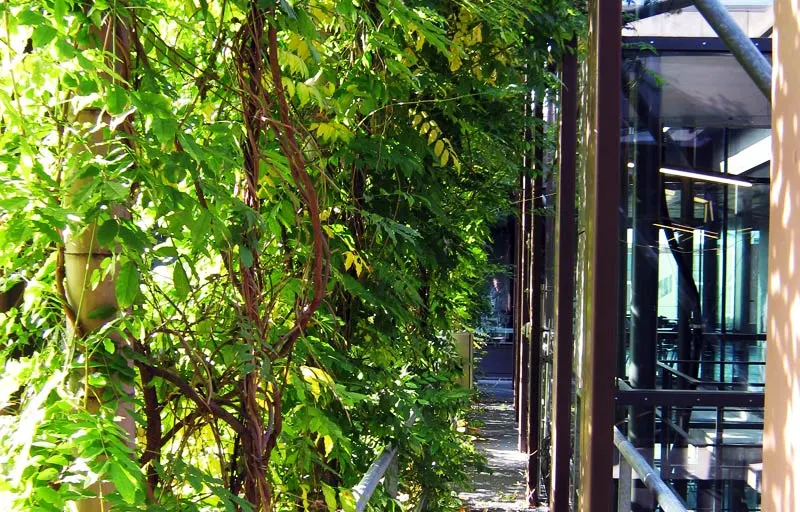Climate Climbers
Building climatization by a façade greening system in Adlershof
As a means to save high tech air conditioning energy, the physics building of Humboldt-Universität zu Berlin (HU) in Adlershof has put on a coat of vegetation that regulates temperature – an extraordinary model.
Sparse winter light still penetrates the large windows on Newtonstrasse, but the first rays of the spring sun will set everything in motion. The first delicate leaves and buds of wisteria, clematis and grape ivy will sprout and, with every sunny day, grow that little bit further up the futuristic facade of the Humboldt- Universität’s (HU) physics building.
As soon as the light intensifies and the heat starts to become oppressive, they will grow tighter until they have provided a protective envelope for the glass walls of the laboratories and auditoriums in the height of summer. It’s a beautiful sight, but there’s more besides: an extraordinary urban ecology project for the sustainable use of water and energy. In a simple and ecofriendly manner, these climbing plants provide what is otherwise the responsibility of energy devouring air conditioners: they cool the building.
From the very outset, the experiment was supervised and monitored by scientists from the Technische Universität Berlin (TU), the HU and Neubrandenburg University of Applied Sciences. They measure the quantities of water consumed by each plant species and the cooling effects they generate through evaporation. Temperatures and emissions are documented, and the levels in the rainwater channels regulated and monitored via a web based computer system. Marco Schmidt was there from the first. Today, this engineer presents his work all over the world, when he talks about the project and encourages others to do the same and refine the results. “Impermeable surfaces like roofs and roadtops alter the microclimate,” he explained. “Solar irradiation converted to heat makes the indoor environment uncomfortable.”
On the other hand, roofs and facades with vegetative cover – like on the physics building in Adlershof – deflect the blazing heat of high summer: they provide shade and evaporating water has a cooling effect. The use of rainwater is practical anyway: “There are a growing number of sealed surfaces in urban areas. Drainage channels must then be laid that can draw off accruing rainwater,” explained Schmidt.
The Physics Institute is one of the few buildings in Germany that does not have an external rainwater drainage system. Instead, the water is collected in cisterns and used for irrigation. The rest flows into a pond in the inner courtyard where it seeps away. Rainwater also has an active role in the institute’s air conditioners: Even at outside temperatures of 30° C, the air is precooled in the heat exchanger to such an extent that it arrives in the rooms at a pleasant 20–22° C – without any other artificial cooling methods. Engineers and scientists come to Adlershof from all over the world to tour this installation. After all, the energy needed to cool buildings and its costs are growing everywhere.
By Karla Zuber for Adlershof Special
